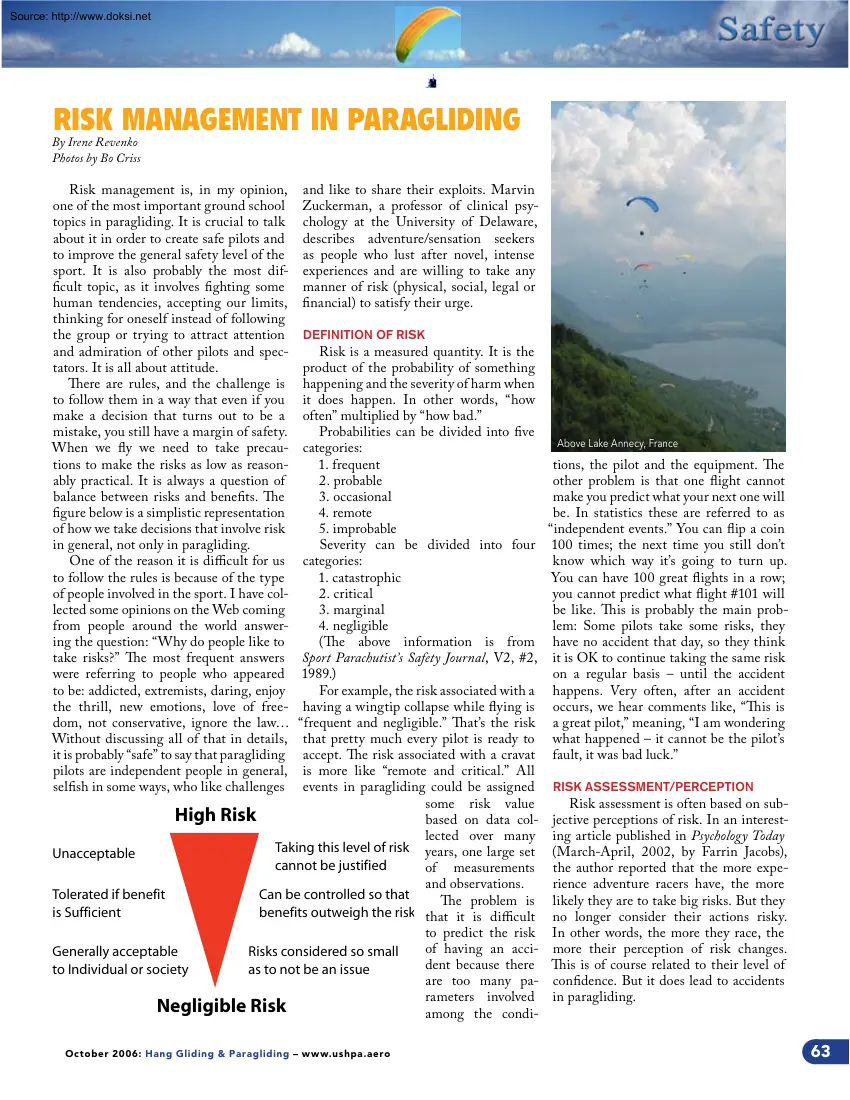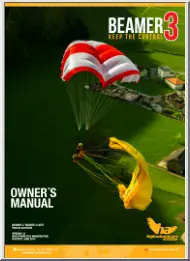Értékelések
Nincs még értékelés. Legyél Te az első!
Mit olvastak a többiek, ha ezzel végeztek?
Tartalmi kivonat
Source: http://www.doksinet RISK MANAGEMENT IN PARAGLIDING By Irene Revenko Photos by Bo Criss Risk management is, in my opinion, and like to share their exploits. Marvin one of the most important ground school Zuckerman, a professor of clinical psytopics in paragliding. It is crucial to talk chology at the University of Delaware, about it in order to create safe pilots and describes adventure/sensation seekers to improve the general safety level of the as people who lust after novel, intense sport. It is also probably the most dif- experiences and are willing to take any ficult topic, as it involves fighting some manner of risk (physical, social, legal or human tendencies, accepting our limits, financial) to satisfy their urge. thinking for oneself instead of following the group or trying to attract attention DEFINITION OF RISK and admiration of other pilots and specRisk is a measured quantity. It is the tators. It is all about attitude product of the probability of something There
are rules, and the challenge is happening and the severity of harm when to follow them in a way that even if you it does happen. In other words, “how make a decision that turns out to be a often” multiplied by “how bad.” Probabilities can be divided into five mistake, you still have a margin of safety. Above Lake Annecy, France When we fly we need to take precau- categories: 1. frequent tions to make the risks as low as reasontions, the pilot and the equipment. The 2. probable ably practical. It is always a question of other problem is that one flight cannot 3. occasional balance between risks and benefits. The make you predict what your next one will 4. remote figure below is a simplistic representation be. In statistics these are referred to as 5. improbable of how we take decisions that involve risk “independent events.” You can flip a coin Severity can be divided into four 100 times; the next time you still don’t in general, not only in paragliding. One of the reason
it is difficult for us categories: know which way it’s going to turn up. 1. catastrophic to follow the rules is because of the type You can have 100 great flights in a row; 2. critical of people involved in the sport. I have colyou cannot predict what flight #101 will 3. marginal lected some opinions on the Web coming be like. This is probably the main prob4 negligible from people around the world answerlem: Some pilots take some risks, they (The above information is from have no accident that day, so they think ing the question: “Why do people like to take risks?” The most frequent answers Sport Parachutist’s Safety Journal, V2, #2, it is OK to continue taking the same risk were referring to people who appeared 1989.) on a regular basis – until the accident For example, the risk associated with a happens. Very often, after an accident to be: addicted, extremists, daring, enjoy the thrill, new emotions, love of free- having a wingtip collapse while flying is occurs, we hear
comments like, “This is dom, not conservative, ignore the law “frequent and negligible.” That’s the risk a great pilot,” meaning, “I am wondering Without discussing all of that in details, that pretty much every pilot is ready to what happened – it cannot be the pilot’s it is probably “safe” to say that paragliding accept. The risk associated with a cravat fault, it was bad luck” pilots are independent people in general, is more like “remote and critical.” All selfish in some ways, who like challenges events in paragliding could be assigned RISK ASSESSMENT/PERCEPTION some risk value Risk assessment is often based on subHigh Risk based on data col- jective perceptions of risk. In an interestlected over many ing article published in Psychology Today Taking this level of risk years, one large set (March-April, 2002, by Farrin Jacobs), Unacceptable cannot be justified of measurements the author reported that the more experience adventure racers have, the more and
observations. Tolerated if benefit Can be controlled so that The problem is likely they are to take big risks. But they is Sufficient benefits outweigh the risks that it is difficult no longer consider their actions risky. to predict the risk In other words, the more they race, the of having an acci- more their perception of risk changes. Generally acceptable Risks considered so small dent because there This is of course related to their level of to Individual or society as to not be an issue are too many pa- confidence. But it does lead to accidents rameters involved in paragliding. Negligible Risk among the condiOc tober 2006: Hang Gliding & Paragliding – w w w.ushpaaero 63 Source: http://www.doksinet PREVENTION OF RISKS Now let’s imagine the perfect pilot, flying the perfect site (big launch, big LZ, no obstacles), in the perfect conditions. It is someone who has the complete gear that is in good shape She (it has to be a woman to be so perfect!) is in a good mood
today, her ego in general is not interfering with her decisions, the weather is great and there are already some happy pilots in the sky reporting dream conditions with good lift, no turbulence. So, here is our pilot launching, flying far from the ground. What are the risks that an accident will happen? Very low. An unpredictable turbulent mass of air that the pilot will encounter close to the ground, or a collision with someone flying into her from her back? How often does this happen in reality? This is hard to tell, but probably not very often. But, what is for sure, is that most of the reported accidents in paragliding have been described as pilot error. It used to make me feel better to know that, because then I would think, “Oh well, I would not have done that, not me.” But after accumulating mistakes myself I’ve had to become more humble. The reality is that we all make mistakes, all the time. So don’t use that as an excuse, it is the worst one. “Oh, she had an
accident because she made a mistake.” The biggest mistake is to think that we won’t make any. We all do There is no classification of risks I think, because they are all related to our behavior. The most important fact, by far, French Pilots 64 is that the risk of accident can be reduced with the right attitude. The main danger in paragliding is the pilot. Here are the things that are important to decrease the risks in paragliding: 1) Mental awareness: -Acknowledge the risks, don’t deny them. -Be aware of all the types of accidents that can happen, take all the preventions against them and, most importantly, admit that we all make mistakes and that’s why we need to follow some safety rules. -Listen to more experienced pilots’ advice; pick a good mentor. Chances are that your flying styles will match. -Assess your mental and physical health. -Know your limits, i.e your level Always ask yourself, “What kind of pilot am I?” -Question yourself about a series of incidents
(forgot your helmet at launch, landed out, disgraceful landing) and take them as warnings. Make the effort to debrief. -Listen to your intuition. Get a sense of the site and the conditions for yourself. When in doubt, don’t fly. I think women are better at that – but I was surprised to see that in France (see table) female pilots have roughly the same percentage of accidents as men (although for some reasons they are less involved in fatal accidents). The following advice comes from Chris Santacroce: “Be aware that your overall flying enjoyment and success will run through a few cycles; you will have a series of good flights and then some bad flights. Stay aware of where you are in this evolution. Adjust your decision-making accordingly. “The question becomes: What does it take to be in an accident? What are the precursors? It is actually not a mystery. There are not so many ‘unlucky’ accidents. St. Hilaire, France There are warnings! Often a sequence of three (bad
landing the day before, forgot to attach your speed bar, didn’t check the wind strength) will be your indication that you are headed for trouble. “Cultivate your ‘healthy flying mindset.’ It’s a full-time job” 2) Practical advice: -Use the right equipment and check your equipment all the time. -Know the preventive or corrective action plans. The benefits of attending SIV clinics are obvious here. -Continuing education can only be beneficial. -Fly far from the ground. Terrain clearance is a key factor. -Know the weather. -Note that the so-called “intermediate syndrome” is not exclusive to intermediate pilots! At all levels we can think we are better pilots than what we are. CONCLUSION Knowledge, skills and attitude are key ingredients to make the sport safer. It is about you as an individual. Even though this is a dangerous sport, if you exercise your new skills and avoid allowing your ego to stop you from making rational decisions, you can decrease the risks a lot.
Irene Revenko learned to fly in her native country of France over a dozen years ago, earned her basic USHPA instructor rating in the spring of 2003 and her advanced instructor rating in the spring of 2005. She enjoys thermal and cross-country flying and has competed for the last four years, placing second or third for women at the 2001, 2003 and 2004 U.S National Paragliding Championships. She has a PhD in bioengineering, and when she’s not flying or competing she works as a physician (clinical pathologist). She has two wonderful children, Tania, age nine, and six-year-old Alexander. Oc tober 2006: Hang Gliding & Paragliding – w w w.ushpaaero
are rules, and the challenge is happening and the severity of harm when to follow them in a way that even if you it does happen. In other words, “how make a decision that turns out to be a often” multiplied by “how bad.” Probabilities can be divided into five mistake, you still have a margin of safety. Above Lake Annecy, France When we fly we need to take precau- categories: 1. frequent tions to make the risks as low as reasontions, the pilot and the equipment. The 2. probable ably practical. It is always a question of other problem is that one flight cannot 3. occasional balance between risks and benefits. The make you predict what your next one will 4. remote figure below is a simplistic representation be. In statistics these are referred to as 5. improbable of how we take decisions that involve risk “independent events.” You can flip a coin Severity can be divided into four 100 times; the next time you still don’t in general, not only in paragliding. One of the reason
it is difficult for us categories: know which way it’s going to turn up. 1. catastrophic to follow the rules is because of the type You can have 100 great flights in a row; 2. critical of people involved in the sport. I have colyou cannot predict what flight #101 will 3. marginal lected some opinions on the Web coming be like. This is probably the main prob4 negligible from people around the world answerlem: Some pilots take some risks, they (The above information is from have no accident that day, so they think ing the question: “Why do people like to take risks?” The most frequent answers Sport Parachutist’s Safety Journal, V2, #2, it is OK to continue taking the same risk were referring to people who appeared 1989.) on a regular basis – until the accident For example, the risk associated with a happens. Very often, after an accident to be: addicted, extremists, daring, enjoy the thrill, new emotions, love of free- having a wingtip collapse while flying is occurs, we hear
comments like, “This is dom, not conservative, ignore the law “frequent and negligible.” That’s the risk a great pilot,” meaning, “I am wondering Without discussing all of that in details, that pretty much every pilot is ready to what happened – it cannot be the pilot’s it is probably “safe” to say that paragliding accept. The risk associated with a cravat fault, it was bad luck” pilots are independent people in general, is more like “remote and critical.” All selfish in some ways, who like challenges events in paragliding could be assigned RISK ASSESSMENT/PERCEPTION some risk value Risk assessment is often based on subHigh Risk based on data col- jective perceptions of risk. In an interestlected over many ing article published in Psychology Today Taking this level of risk years, one large set (March-April, 2002, by Farrin Jacobs), Unacceptable cannot be justified of measurements the author reported that the more experience adventure racers have, the more and
observations. Tolerated if benefit Can be controlled so that The problem is likely they are to take big risks. But they is Sufficient benefits outweigh the risks that it is difficult no longer consider their actions risky. to predict the risk In other words, the more they race, the of having an acci- more their perception of risk changes. Generally acceptable Risks considered so small dent because there This is of course related to their level of to Individual or society as to not be an issue are too many pa- confidence. But it does lead to accidents rameters involved in paragliding. Negligible Risk among the condiOc tober 2006: Hang Gliding & Paragliding – w w w.ushpaaero 63 Source: http://www.doksinet PREVENTION OF RISKS Now let’s imagine the perfect pilot, flying the perfect site (big launch, big LZ, no obstacles), in the perfect conditions. It is someone who has the complete gear that is in good shape She (it has to be a woman to be so perfect!) is in a good mood
today, her ego in general is not interfering with her decisions, the weather is great and there are already some happy pilots in the sky reporting dream conditions with good lift, no turbulence. So, here is our pilot launching, flying far from the ground. What are the risks that an accident will happen? Very low. An unpredictable turbulent mass of air that the pilot will encounter close to the ground, or a collision with someone flying into her from her back? How often does this happen in reality? This is hard to tell, but probably not very often. But, what is for sure, is that most of the reported accidents in paragliding have been described as pilot error. It used to make me feel better to know that, because then I would think, “Oh well, I would not have done that, not me.” But after accumulating mistakes myself I’ve had to become more humble. The reality is that we all make mistakes, all the time. So don’t use that as an excuse, it is the worst one. “Oh, she had an
accident because she made a mistake.” The biggest mistake is to think that we won’t make any. We all do There is no classification of risks I think, because they are all related to our behavior. The most important fact, by far, French Pilots 64 is that the risk of accident can be reduced with the right attitude. The main danger in paragliding is the pilot. Here are the things that are important to decrease the risks in paragliding: 1) Mental awareness: -Acknowledge the risks, don’t deny them. -Be aware of all the types of accidents that can happen, take all the preventions against them and, most importantly, admit that we all make mistakes and that’s why we need to follow some safety rules. -Listen to more experienced pilots’ advice; pick a good mentor. Chances are that your flying styles will match. -Assess your mental and physical health. -Know your limits, i.e your level Always ask yourself, “What kind of pilot am I?” -Question yourself about a series of incidents
(forgot your helmet at launch, landed out, disgraceful landing) and take them as warnings. Make the effort to debrief. -Listen to your intuition. Get a sense of the site and the conditions for yourself. When in doubt, don’t fly. I think women are better at that – but I was surprised to see that in France (see table) female pilots have roughly the same percentage of accidents as men (although for some reasons they are less involved in fatal accidents). The following advice comes from Chris Santacroce: “Be aware that your overall flying enjoyment and success will run through a few cycles; you will have a series of good flights and then some bad flights. Stay aware of where you are in this evolution. Adjust your decision-making accordingly. “The question becomes: What does it take to be in an accident? What are the precursors? It is actually not a mystery. There are not so many ‘unlucky’ accidents. St. Hilaire, France There are warnings! Often a sequence of three (bad
landing the day before, forgot to attach your speed bar, didn’t check the wind strength) will be your indication that you are headed for trouble. “Cultivate your ‘healthy flying mindset.’ It’s a full-time job” 2) Practical advice: -Use the right equipment and check your equipment all the time. -Know the preventive or corrective action plans. The benefits of attending SIV clinics are obvious here. -Continuing education can only be beneficial. -Fly far from the ground. Terrain clearance is a key factor. -Know the weather. -Note that the so-called “intermediate syndrome” is not exclusive to intermediate pilots! At all levels we can think we are better pilots than what we are. CONCLUSION Knowledge, skills and attitude are key ingredients to make the sport safer. It is about you as an individual. Even though this is a dangerous sport, if you exercise your new skills and avoid allowing your ego to stop you from making rational decisions, you can decrease the risks a lot.
Irene Revenko learned to fly in her native country of France over a dozen years ago, earned her basic USHPA instructor rating in the spring of 2003 and her advanced instructor rating in the spring of 2005. She enjoys thermal and cross-country flying and has competed for the last four years, placing second or third for women at the 2001, 2003 and 2004 U.S National Paragliding Championships. She has a PhD in bioengineering, and when she’s not flying or competing she works as a physician (clinical pathologist). She has two wonderful children, Tania, age nine, and six-year-old Alexander. Oc tober 2006: Hang Gliding & Paragliding – w w w.ushpaaero





